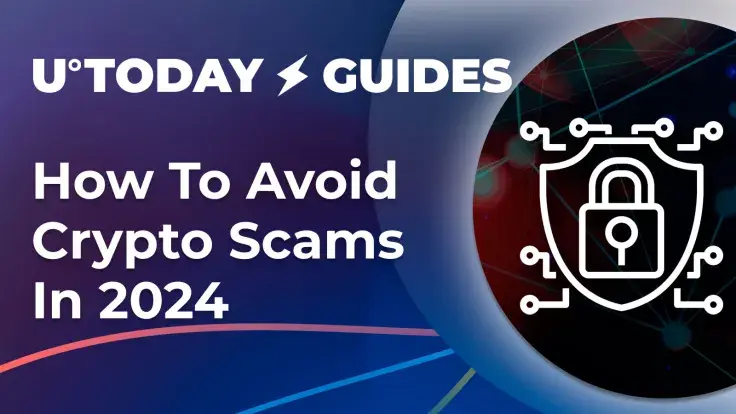
Disclaimer: The opinions expressed by our writers are their own and do not represent the views of U.Today. The financial and market information provided on U.Today is intended for informational purposes only. U.Today is not liable for any financial losses incurred while trading cryptocurrencies. Conduct your own research by contacting financial experts before making any investment decisions. We believe that all content is accurate as of the date of publication, but certain offers mentioned may no longer be available.
As we fully step into 2024, regulatory scrutiny in the crypto realm persists. From the SEC going after celebrities promoting crypto assets, including Lindsay Lohan and Jake Paul, to the epic Sam Bankman-Fried trial, the crypto market took a hard hit last year, to say the least. The crusade against crypto fraud and scams prevails into 2024, with approximately $2 billion reported lost in the crypto sphere in 2023, according to a CertiK report.
The crypto world, by its definition, is open to vulnerabilities. While trying to get your money back after falling for a scam is extremely difficult, it is crucial to be cautious about any presented opportunity at every step, from initial information to actual transactions.
Basic tips to avoid scams
- Do not trust big profit promises
Cryptocurrency investments inherently carry risks, and scams often prey on the desire for quick profits. Scammers entice victims with promises of unrealistically high returns, doubling investments, or free money. Always approach such claims with skepticism and conduct thorough research before considering any investment.
- Check for errors in emails and messages
Scammers often use communication channels with misspellings, grammatical errors, or inconsistencies. Real entities maintain a professional and error-free communication style.
- Avoid transactions with unclear details
Legitimate investment opportunities provide clear and transparent information about how funds will be used and the expected returns. Scams, on the other hand, often lack clarity and specifics.
- Look for manipulation tactics
Scammers may use coercive tactics like extortion or present seemingly binding contracts to trap individuals. Always scrutinize any contractual obligations, and be wary of threats or manipulation attempts. This also applies to private texting with someone you don’t know.
- Question celebrity endorsements
If an endorsement seems out of place or unusual, take the time to verify its authenticity. Real endorsements are typically well-documented and consistent, as influencers are generally cautious about the projects they associate with.
Why market matters
The more bullish the market gets, the more unqualified traders will rush in on every possible asset available. 2023 marked a recovery for cryptocurrencies, with significant returns for blue-chip tokens like Bitcoin and Ethereum. According to research by Chainalytics, scams tend to generate less revenue during crypto market declines, as shown in the graph correlating scam revenue with Bitcoin prices in 2022.
Scam revenue throughout the year tracks almost perfectly with Bitcoin's price, consistently maintaining a three-week lag between price moves and changes in revenue. However, not every distinct type of scam follows this pattern — some types of scams see revenue changes increase as crypto asset prices decrease. In 2021, Bitcoin was the favored cryptocurrency for cybercriminals, likely due to its high liquidity. Nevertheless, there has been a shift in the last two years, with stablecoins now constituting the majority of illicit transaction volume.
Whether or not the crypto market rebounds in 2024, it is safe to assume that scammers’ tactics will become ever more sophisticated. Here are the most common types of schemes in 2024.
Pump and dump scams
When the market sentiment is strong, more people will be looking for high-yield opportunities. A pump and dump scam is when a group of people work together to inflate (pump) the price of a newly created cryptocurrency and then quickly sell it off (dump) to make a profit. According to Chainalysis, about 24% of new tokens in 2022 were based on pump and dump schemes. Here's how it works:
- Scammers buy a lesser-known cryptocurrency when its price is low.
- They create excitement about the crypto, often through social media, making it seem like a great investment.
- Others see the hype and start buying the crypto, hoping to make money.
- As more people invest, the crypto's price goes up.
- Once the price reaches a high point, the scammers sell all their crypto, making a profit.
- With a sudden drop in the price, people who bought at highs end up losing money.
AI scams
The ascent of AI equips scammers with advanced deceptive tools. AI-powered chatbots and virtual assistants can promote fake tokens, coordinate pump-and-dump schemes, or provide misleading investment advice. Last year saw a growing number of deepfake video ads, and the trend continues into 2024. Fraudsters often exploit high-profile figures' images and AI-generated videos to endorse fraudulent crypto projects, utilizing deepfake technology.
Deceptive deepfake videos lure viewers with promises of doubling cryptocurrency investments through QR codes. Compromising YouTube access tokens, attackers quickly transform channels to impersonate entities, redirecting to malicious sites promoting crypto-doubling scams. The most recent example includes a deepfake video of Solana co-founder Anatoly Yakovenko offering a giveaway via a QR code that leads to a phishing link.
In addition, the Commodity Futures Trading Commission (CFTC) has recently warned of scams using AI to promise large returns through crypto arbitrage algorithms. In this case, scammers exploit AI's growing use, making false claims about significant profits. The CFTC identified several fraud schemes, including one causing a loss of 30,000 Bitcoins ($1.7 billion).
Pig butchering
This is one of the latest and, as some studies show, one of the most effective scams in 2024. Pig butchering, also referred to as "romance scams," uses emotional manipulation to deceive people into surrendering valuable crypto assets. Beginning on social media or dating apps, these scams use a prolonged strategy to manipulate victims into making crypto payments or investing in fraudulent projects.
So, how does it work? Basically, scammers create a fake online identity with an attractive photo, engaging victims in harmless conversations before shifting the discussion to investments and encouraging them to open an account at a suggested online brokerage. Stay cautious to avoid falling victim to these deceptive tactics.
Reports indicate that pig butchering has become one of the prevalent scams within the crypto community. However, obtaining precise data on recent fraud numbers is challenging, primarily because pig butchering tends to be underreported. Victims often hesitate to come forward, driven by embarrassment resulting from falling prey to this particular scam.
Investment scams
Apparently, crypto investment scams are not going anywhere. As a matter of fact, Lloyds Bank has recently reported a 23% increase in 2023. As opposed to more traditional financial markets, these scams exploit the decentralized and relatively unregulated nature of the crypto market to target unsuspecting investors.
Scammers often promise exceptionally high and guaranteed returns on investments, enticing their victims with the prospect of quick profits. It is important to know that investment scams typically lack transparency regarding the use of funds and the underlying mechanisms of the investment. Legitimate projects provide detailed information about their goals, technology and team.
Biggest crypto scams in history
| Company | Estimated losses by holders | Year |
OneCoin | $25 billion | 2016 |
FTX Trading LPlusTokentd. (FTX) | $8 billion | 2019–2022 |
PlusToken | $4 billion | 2018–2019 |
BitConnect | $2 billion | 2016–2018 |
Bitclub Network | $722 million | 2014–2019 |
Phishing scams
Phishing continues to be a widespread issue, as scammers deploy deceitful emails and links to fraudulent websites, aiming to collect personal information. For instance, MetaMask, Blockstream and Trezor have recently been attacked with new and dangerous phishing designs.
Data suggests approval phishing schemes are on the rise, with at least $374.6 million stolen from wallets in 2023. Scammers trick users into approving malicious blockchain transactions, permitting them to spend specific tokens in the victim's wallet. Funds are often redirected by a spender to a separate wallet. Detecting this scam involves recognizing the pattern where the approved spender initiates the draining transaction, requiring further investigation for confirmation.
Double scams
With more investment scams ending up in court convictions, other fraudsters lean into the victims’ search for recovery. The rise of "double scams" adds complexity to crypto fraud. Victims face a second wave from firms posing as recovery agents, promising to reclaim lost funds for fees.
In most cases, fake recovery agents engage in advanced fee fraud, extracting payments for non-existent services. The situation worsens as fraudsters sell victims' details, subjecting them to ongoing harassment and additional extortion attempts. Crypto double scams compound victims' reluctance to admit fraud, fostering isolation and inhibiting disclosure to friends or family.
What is key in avoiding scams?
For crypto traders, risk is an essential part of the deal. The very decentralized nature and irreversible transactions of cryptocurrencies expose the landscape to significant vulnerabilities. Retrieving funds post-crypto scam becomes an insurmountable challenge. The best way to defend yourself is to stay vigilant, detect scams early and be cautious in your involvement.


 Alex Dovbnya
Alex Dovbnya Dan Burgin
Dan Burgin Arman Shirinyan
Arman Shirinyan Denys Serhiichuk
Denys Serhiichuk